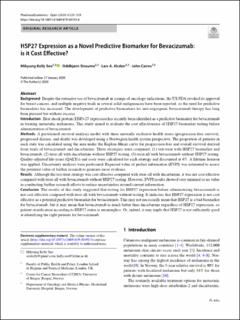| dc.contributor.author | Seo, Mikyung Kelly | |
| dc.contributor.author | Straume, Oddbjørn | |
| dc.contributor.author | Akslen, Lars A. | |
| dc.contributor.author | Cairns, John Alexander | |
| dc.date.accessioned | 2021-07-07T08:39:03Z | |
| dc.date.available | 2021-07-07T08:39:03Z | |
| dc.date.created | 2021-01-29T14:11:05Z | |
| dc.date.issued | 2020 | |
| dc.identifier.issn | 2509-4262 | |
| dc.identifier.uri | https://hdl.handle.net/11250/2763672 | |
| dc.description.abstract | Background: Despite the extensive use of bevacizumab in a range of oncology indications, the US FDA revoked its approval for breast cancers, and multiple negative trials in several solid malignancies have been reported, so the need for predictive biomarkers has increased. The development of predictive biomarkers for anti-angiogenic bevacizumab therapy has long been pursued but without success.
Introduction: Heat shock protein (HSP)-27 expression has recently been identified as a predictive biomarker for bevacizumab in treating metastatic melanoma. This study aimed to evaluate the cost effectiveness of HSP27 biomarker testing before administration of bevacizumab.
Methods: A partitioned survival analysis model with three mutually exclusive health states (progression-free survival, progressed disease, and death) was developed using a Norwegian health system perspective. The proportion of patients in each state was calculated using the area under the Kaplan–Meier curve for progression-free and overall survival derived from trials of bevacizumab and dacarbazine. Three strategies were compared: (1) test-treat with HSP27 biomarker and bevacizumab, (2) treat-all with dacarbazine without HSP27 testing, (3) treat-all with bevacizumab without HSP27 testing. Quality-adjusted life-years (QALYs) and costs were calculated for each strategy and discounted at 4%. A lifetime horizon was applied. Uncertainty analyses were performed. Expected value of perfect information (EVPI) was estimated to assess the potential value of further research to generate more evidence.
Results: Although the test-treat strategy was cost effective compared with treat-all with dacarbazine, it was not cost effective compared with treat-all with bevacizumab without HSP27 testing. However, EVPI results showed very minimal or no value in conducting further research efforts to reduce uncertainties around current information.
Conclusion: The results of this study suggested that testing for HSP27 expression before administering bevacizumab is not cost effective compared with treat-all with bevacizumab without testing. It indicates that HSP27 expression is not cost effective as a potential predictive biomarker for bevacizumab. This may not necessarily mean that HSP27 is a bad biomarker for bevacizumab, but it may mean that bevacizumab is much better than dacarbazine regardless of HSP27 expression, so patient stratification according to HSP27 status is meaningless. Or, indeed, it may imply that HSP27 is not sufficiently good at identifying the right patients for bevacizumab. | en_US |
| dc.language.iso | eng | en_US |
| dc.publisher | Springer | en_US |
| dc.rights | Navngivelse-Ikkekommersiell 4.0 Internasjonal | * |
| dc.rights.uri | http://creativecommons.org/licenses/by-nc/4.0/deed.no | * |
| dc.title | HSP27 Expression as a Novel Predictive Biomarker for Bevacizumab: is it Cost Effective? | en_US |
| dc.type | Journal article | en_US |
| dc.type | Peer reviewed | en_US |
| dc.description.version | publishedVersion | en_US |
| dc.rights.holder | Copyright the authors 2020 | en_US |
| cristin.ispublished | true | |
| cristin.fulltext | original | |
| cristin.qualitycode | 1 | |
| dc.identifier.doi | 10.1007/s41669-019-00193-8 | |
| dc.identifier.cristin | 1882534 | |
| dc.source.journal | PharmacoEconomics - Open | en_US |
| dc.source.pagenumber | 529–539 | en_US |
| dc.identifier.citation | PharmacoEconomics - Open. 2020, 4, 529–539. | en_US |
| dc.source.volume | 4 | en_US |

